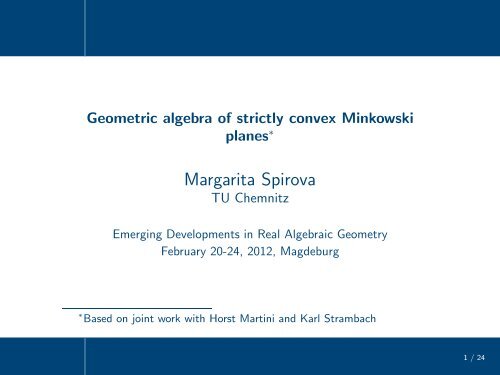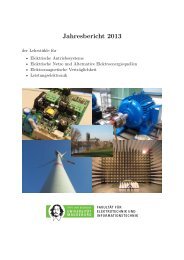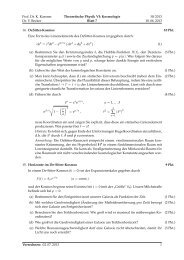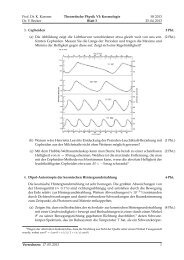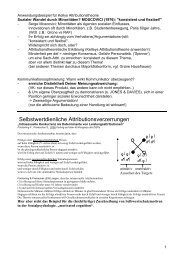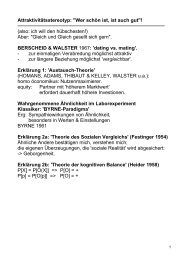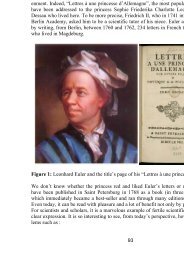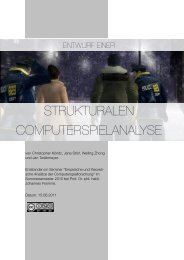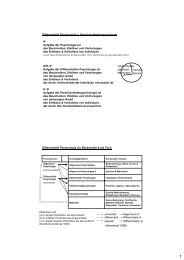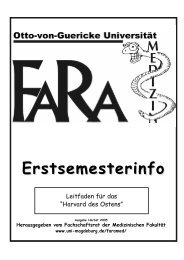Geometric algebra of strictly convex Minkowski planes
Geometric algebra of strictly convex Minkowski planes
Geometric algebra of strictly convex Minkowski planes
Create successful ePaper yourself
Turn your PDF publications into a flip-book with our unique Google optimized e-Paper software.
<strong>Geometric</strong> <strong>algebra</strong> <strong>of</strong> <strong>strictly</strong> <strong>convex</strong> <strong>Minkowski</strong><br />
<strong>planes</strong> ∗<br />
Margarita Spirova<br />
TU Chemnitz<br />
Emerging Developments in Real Algebraic Geometry<br />
February 20-24, 2012, Magdeburg<br />
∗ Based on joint work with Horst Martini and Karl Strambach<br />
1 / 24
Motivation<br />
Isometries in<br />
<strong>Minkowski</strong> spaces<br />
Reflections in<br />
<strong>Minkowski</strong> <strong>planes</strong><br />
Preliminares<br />
Isometries in<br />
<strong>Minkowski</strong> <strong>planes</strong><br />
and reflections in<br />
the group <strong>of</strong> affine<br />
transformations<br />
Left-reflections in<br />
<strong>Minkowski</strong> <strong>planes</strong><br />
Cycles in <strong>strictly</strong><br />
<strong>convex</strong> <strong>Minkowski</strong><br />
<strong>planes</strong><br />
Motivation<br />
2 / 24
Motivation<br />
Isometries in<br />
<strong>Minkowski</strong> spaces<br />
Reflections in<br />
<strong>Minkowski</strong> <strong>planes</strong><br />
Preliminares<br />
Isometries in<br />
<strong>Minkowski</strong> <strong>planes</strong><br />
and reflections in<br />
the group <strong>of</strong> affine<br />
transformations<br />
Left-reflections in<br />
<strong>Minkowski</strong> <strong>planes</strong><br />
Cycles in <strong>strictly</strong><br />
<strong>convex</strong> <strong>Minkowski</strong><br />
<strong>planes</strong><br />
Isometries in <strong>Minkowski</strong> spaces<br />
Let (M d ,·) be a <strong>Minkowski</strong> space, i.e., a finite dimensional real<br />
vector space equipped with a norm ·.<br />
3 / 24
Motivation<br />
Isometries in<br />
<strong>Minkowski</strong> spaces<br />
Reflections in<br />
<strong>Minkowski</strong> <strong>planes</strong><br />
Preliminares<br />
Isometries in<br />
<strong>Minkowski</strong> <strong>planes</strong><br />
and reflections in<br />
the group <strong>of</strong> affine<br />
transformations<br />
Left-reflections in<br />
<strong>Minkowski</strong> <strong>planes</strong><br />
Cycles in <strong>strictly</strong><br />
<strong>convex</strong> <strong>Minkowski</strong><br />
<strong>planes</strong><br />
Isometries in <strong>Minkowski</strong> spaces<br />
Let (M d ,·) be a <strong>Minkowski</strong> space, i.e., a finite dimensional real<br />
vector space equipped with a norm ·.<br />
An isometry from (X,·X) to (Y,·Y) is a mapping such that<br />
for all x1,x2 in X we have<br />
x1 −x2X = Tx1 −Tx2Y.<br />
3 / 24
Motivation<br />
Isometries in<br />
<strong>Minkowski</strong> spaces<br />
Reflections in<br />
<strong>Minkowski</strong> <strong>planes</strong><br />
Preliminares<br />
Isometries in<br />
<strong>Minkowski</strong> <strong>planes</strong><br />
and reflections in<br />
the group <strong>of</strong> affine<br />
transformations<br />
Left-reflections in<br />
<strong>Minkowski</strong> <strong>planes</strong><br />
Cycles in <strong>strictly</strong><br />
<strong>convex</strong> <strong>Minkowski</strong><br />
<strong>planes</strong><br />
Isometries in <strong>Minkowski</strong> spaces<br />
• Translations, the identity map I, and the symmetry −I are<br />
isometries for any <strong>Minkowski</strong> space.<br />
3 / 24
Motivation<br />
Isometries in<br />
<strong>Minkowski</strong> spaces<br />
Reflections in<br />
<strong>Minkowski</strong> <strong>planes</strong><br />
Preliminares<br />
Isometries in<br />
<strong>Minkowski</strong> <strong>planes</strong><br />
and reflections in<br />
the group <strong>of</strong> affine<br />
transformations<br />
Left-reflections in<br />
<strong>Minkowski</strong> <strong>planes</strong><br />
Cycles in <strong>strictly</strong><br />
<strong>convex</strong> <strong>Minkowski</strong><br />
<strong>planes</strong><br />
Isometries in <strong>Minkowski</strong> spaces<br />
• Translations, the identity map I, and the symmetry −I are<br />
isometries for any <strong>Minkowski</strong> space.<br />
• Mazur-Ulam Theorem: If (X,·X) to (Y,·Y) are<br />
<strong>Minkowski</strong> spaces and T is an isometry <strong>of</strong> (X,·X) into<br />
(Y,·Y) with T(0) = 0 then T is linear.<br />
3 / 24
Motivation<br />
Isometries in<br />
<strong>Minkowski</strong> spaces<br />
Reflections in<br />
<strong>Minkowski</strong> <strong>planes</strong><br />
Preliminares<br />
Isometries in<br />
<strong>Minkowski</strong> <strong>planes</strong><br />
and reflections in<br />
the group <strong>of</strong> affine<br />
transformations<br />
Left-reflections in<br />
<strong>Minkowski</strong> <strong>planes</strong><br />
Cycles in <strong>strictly</strong><br />
<strong>convex</strong> <strong>Minkowski</strong><br />
<strong>planes</strong><br />
Isometries in <strong>Minkowski</strong> spaces<br />
• Translations, the identity map I, and the symmetry −I are<br />
isometries for any <strong>Minkowski</strong> space.<br />
• Mazur-Ulam Theorem: If (X,·X) to (Y,·Y) are<br />
<strong>Minkowski</strong> spaces and T is an isometry <strong>of</strong> (X,·X) into<br />
(Y,·Y) with T(0) = 0 then T is linear.<br />
• Álvarez Paiva-Thompson Remark: A general <strong>Minkowski</strong><br />
plane does not admit many isometries itself.<br />
3 / 24
Motivation<br />
Isometries in<br />
<strong>Minkowski</strong> spaces<br />
Reflections in<br />
<strong>Minkowski</strong> <strong>planes</strong><br />
Preliminares<br />
Isometries in<br />
<strong>Minkowski</strong> <strong>planes</strong><br />
and reflections in<br />
the group <strong>of</strong> affine<br />
transformations<br />
Left-reflections in<br />
<strong>Minkowski</strong> <strong>planes</strong><br />
Cycles in <strong>strictly</strong><br />
<strong>convex</strong> <strong>Minkowski</strong><br />
<strong>planes</strong><br />
Isometries in <strong>Minkowski</strong> spaces<br />
• Translations, the identity map I, and the symmetry −I are<br />
isometries for any <strong>Minkowski</strong> space.<br />
• Mazur-Ulam Theorem: If (X,·X) to (Y,·Y) are<br />
<strong>Minkowski</strong> spaces and T is an isometry <strong>of</strong> (X,·X) into<br />
(Y,·Y) with T(0) = 0 then T is linear.<br />
• Álvarez Paiva-Thompson Remark: A general <strong>Minkowski</strong><br />
plane does not admit many isometries itself.<br />
⎧<br />
⎨<br />
⎩<br />
x = (ξ1,ξ2) :=<br />
|ξ1|+2 −1 |ξ2| if sgnξ1 = sgnξ1 and |ξ2| ≤ 2|ξ1|,<br />
|ξ2| if sgnξ1 = sgnξ1 and |ξ2| > 2|ξ1|,<br />
(ξ2 1 +ξ2 2 )12<br />
if sgnξ1 = −sgnξ1.<br />
3 / 24
Motivation<br />
Isometries in<br />
<strong>Minkowski</strong> spaces<br />
Reflections in<br />
<strong>Minkowski</strong> <strong>planes</strong><br />
Preliminares<br />
Isometries in<br />
<strong>Minkowski</strong> <strong>planes</strong><br />
and reflections in<br />
the group <strong>of</strong> affine<br />
transformations<br />
Left-reflections in<br />
<strong>Minkowski</strong> <strong>planes</strong><br />
Cycles in <strong>strictly</strong><br />
<strong>convex</strong> <strong>Minkowski</strong><br />
<strong>planes</strong><br />
Reflections in <strong>Minkowski</strong> <strong>planes</strong><br />
H. Busemann, P. J. Kelly: Projective Geometry and<br />
Projective metrics, New York, 1953.<br />
4 / 24
Motivation<br />
Isometries in<br />
<strong>Minkowski</strong> spaces<br />
Reflections in<br />
<strong>Minkowski</strong> <strong>planes</strong><br />
Preliminares<br />
Isometries in<br />
<strong>Minkowski</strong> <strong>planes</strong><br />
and reflections in<br />
the group <strong>of</strong> affine<br />
transformations<br />
Left-reflections in<br />
<strong>Minkowski</strong> <strong>planes</strong><br />
Cycles in <strong>strictly</strong><br />
<strong>convex</strong> <strong>Minkowski</strong><br />
<strong>planes</strong><br />
Reflections in <strong>Minkowski</strong> <strong>planes</strong><br />
H. Busemann, P. J. Kelly: Projective Geometry and<br />
Projective metrics, New York, 1953.<br />
• An isometry <strong>of</strong> a <strong>Minkowski</strong> plane has either no fixed points,<br />
one fixed point, a line <strong>of</strong> fixed points, or it is identity.<br />
4 / 24
Motivation<br />
Isometries in<br />
<strong>Minkowski</strong> spaces<br />
Reflections in<br />
<strong>Minkowski</strong> <strong>planes</strong><br />
Preliminares<br />
Isometries in<br />
<strong>Minkowski</strong> <strong>planes</strong><br />
and reflections in<br />
the group <strong>of</strong> affine<br />
transformations<br />
Left-reflections in<br />
<strong>Minkowski</strong> <strong>planes</strong><br />
Cycles in <strong>strictly</strong><br />
<strong>convex</strong> <strong>Minkowski</strong><br />
<strong>planes</strong><br />
Reflections in <strong>Minkowski</strong> <strong>planes</strong><br />
H. Busemann, P. J. Kelly: Projective Geometry and<br />
Projective metrics, New York, 1953.<br />
• An isometry <strong>of</strong> a <strong>Minkowski</strong> plane has either no fixed points,<br />
one fixed point, a line <strong>of</strong> fixed points, or it is identity.<br />
• When an isometry Φ is involutory it always has fixed points.<br />
4 / 24
Motivation<br />
Isometries in<br />
<strong>Minkowski</strong> spaces<br />
Reflections in<br />
<strong>Minkowski</strong> <strong>planes</strong><br />
Preliminares<br />
Isometries in<br />
<strong>Minkowski</strong> <strong>planes</strong><br />
and reflections in<br />
the group <strong>of</strong> affine<br />
transformations<br />
Left-reflections in<br />
<strong>Minkowski</strong> <strong>planes</strong><br />
Cycles in <strong>strictly</strong><br />
<strong>convex</strong> <strong>Minkowski</strong><br />
<strong>planes</strong><br />
Reflections in <strong>Minkowski</strong> <strong>planes</strong><br />
H. Busemann, P. J. Kelly: Projective Geometry and<br />
Projective metrics, New York, 1953.<br />
• An isometry <strong>of</strong> a <strong>Minkowski</strong> plane has either no fixed points,<br />
one fixed point, a line <strong>of</strong> fixed points, or it is identity.<br />
• When an isometry Φ is involutory it always has fixed points.If<br />
Φ has a line G <strong>of</strong> fixed points than it is called a reflections in<br />
G.<br />
4 / 24
Motivation<br />
Isometries in<br />
<strong>Minkowski</strong> spaces<br />
Reflections in<br />
<strong>Minkowski</strong> <strong>planes</strong><br />
Preliminares<br />
Isometries in<br />
<strong>Minkowski</strong> <strong>planes</strong><br />
and reflections in<br />
the group <strong>of</strong> affine<br />
transformations<br />
Left-reflections in<br />
<strong>Minkowski</strong> <strong>planes</strong><br />
Cycles in <strong>strictly</strong><br />
<strong>convex</strong> <strong>Minkowski</strong><br />
<strong>planes</strong><br />
Reflections in <strong>Minkowski</strong> <strong>planes</strong><br />
H. Busemann, P. J. Kelly: Projective Geometry and<br />
Projective metrics, New York, 1953.<br />
• An isometry <strong>of</strong> a <strong>Minkowski</strong> plane has either no fixed points,<br />
one fixed point, a line <strong>of</strong> fixed points, or it is identity.<br />
• When an isometry Φ is involutory it always has fixed points.If<br />
Φ has a line G <strong>of</strong> fixed points than it is called a reflections in<br />
G.<br />
• If any line in a <strong>Minkowski</strong> plane M 2 admits a reflection then<br />
M 2 is Euclidean.<br />
4 / 24
Motivation<br />
Isometries in<br />
<strong>Minkowski</strong> spaces<br />
Reflections in<br />
<strong>Minkowski</strong> <strong>planes</strong><br />
Preliminares<br />
Isometries in<br />
<strong>Minkowski</strong> <strong>planes</strong><br />
and reflections in<br />
the group <strong>of</strong> affine<br />
transformations<br />
Left-reflections in<br />
<strong>Minkowski</strong> <strong>planes</strong><br />
Cycles in <strong>strictly</strong><br />
<strong>convex</strong> <strong>Minkowski</strong><br />
<strong>planes</strong><br />
Reflections in <strong>Minkowski</strong> <strong>planes</strong><br />
H. Busemann, P. J. Kelly: Projective Geometry and<br />
Projective metrics, New York, 1953.<br />
• An isometry <strong>of</strong> a <strong>Minkowski</strong> plane has either no fixed points,<br />
one fixed point, a line <strong>of</strong> fixed points, or it is identity.<br />
• When an isometry Φ is involutory it always has fixed points.If<br />
Φ has a line G <strong>of</strong> fixed points than it is called a reflections in<br />
G.<br />
• If any line in a <strong>Minkowski</strong> plane M 2 admits a reflection then<br />
M 2 is Euclidean.<br />
H. Martini, M. S.: Reflections in <strong>strictly</strong> <strong>convex</strong> <strong>Minkowski</strong><br />
<strong>planes</strong>, Aequationes Math. 78 (2009), 71-85.<br />
4 / 24
Motivation<br />
Isometries in<br />
<strong>Minkowski</strong> spaces<br />
Reflections in<br />
<strong>Minkowski</strong> <strong>planes</strong><br />
Preliminares<br />
Isometries in<br />
<strong>Minkowski</strong> <strong>planes</strong><br />
and reflections in<br />
the group <strong>of</strong> affine<br />
transformations<br />
Left-reflections in<br />
<strong>Minkowski</strong> <strong>planes</strong><br />
Cycles in <strong>strictly</strong><br />
<strong>convex</strong> <strong>Minkowski</strong><br />
<strong>planes</strong><br />
Reflections in <strong>Minkowski</strong> <strong>planes</strong><br />
H. Busemann, P. J. Kelly: Projective Geometry and<br />
Projective metrics, New York, 1953.<br />
• An isometry <strong>of</strong> a <strong>Minkowski</strong> plane has either no fixed points,<br />
one fixed point, a line <strong>of</strong> fixed points, or it is identity.<br />
• When an isometry Φ is involutory it always has fixed points.If<br />
Φ has a line G <strong>of</strong> fixed points than it is called a reflections in<br />
G.<br />
• If any line in a <strong>Minkowski</strong> plane M 2 admits a reflection then<br />
M 2 is Euclidean.<br />
H. Martini, M. S.: Reflections in <strong>strictly</strong> <strong>convex</strong> <strong>Minkowski</strong><br />
<strong>planes</strong>, Aequationes Math. 78 (2009), 71-85.<br />
Bachmann, F.: Aufbau der Geometrie aus dem<br />
Spiegelungsbegriff, Springer-Verlag, Berlin-Göttingen-Heidelberg,<br />
1959.<br />
4 / 24
Motivation<br />
Preliminares<br />
Different types <strong>of</strong><br />
orthogonality in<br />
<strong>Minkowski</strong> spaces<br />
Isometries in<br />
<strong>Minkowski</strong> <strong>planes</strong><br />
and reflections in<br />
the group <strong>of</strong> affine<br />
transformations<br />
Left-reflections in<br />
<strong>Minkowski</strong> <strong>planes</strong><br />
Cycles in <strong>strictly</strong><br />
<strong>convex</strong> <strong>Minkowski</strong><br />
<strong>planes</strong><br />
Preliminares<br />
5 / 24
Motivation<br />
Preliminares<br />
Different types <strong>of</strong><br />
orthogonality in<br />
<strong>Minkowski</strong> spaces<br />
Isometries in<br />
<strong>Minkowski</strong> <strong>planes</strong><br />
and reflections in<br />
the group <strong>of</strong> affine<br />
transformations<br />
Left-reflections in<br />
<strong>Minkowski</strong> <strong>planes</strong><br />
Cycles in <strong>strictly</strong><br />
<strong>convex</strong> <strong>Minkowski</strong><br />
<strong>planes</strong><br />
Different types <strong>of</strong> orthogonality in <strong>Minkowski</strong> spaces<br />
Let (M d ,·) be a <strong>Minkowski</strong> space.<br />
6 / 24
Motivation<br />
Preliminares<br />
Different types <strong>of</strong><br />
orthogonality in<br />
<strong>Minkowski</strong> spaces<br />
Isometries in<br />
<strong>Minkowski</strong> <strong>planes</strong><br />
and reflections in<br />
the group <strong>of</strong> affine<br />
transformations<br />
Left-reflections in<br />
<strong>Minkowski</strong> <strong>planes</strong><br />
Cycles in <strong>strictly</strong><br />
<strong>convex</strong> <strong>Minkowski</strong><br />
<strong>planes</strong><br />
Different types <strong>of</strong> orthogonality in <strong>Minkowski</strong> spaces<br />
Birkh<strong>of</strong>f orthogonality<br />
6 / 24
Motivation<br />
Preliminares<br />
Different types <strong>of</strong><br />
orthogonality in<br />
<strong>Minkowski</strong> spaces<br />
Isometries in<br />
<strong>Minkowski</strong> <strong>planes</strong><br />
and reflections in<br />
the group <strong>of</strong> affine<br />
transformations<br />
Left-reflections in<br />
<strong>Minkowski</strong> <strong>planes</strong><br />
Cycles in <strong>strictly</strong><br />
<strong>convex</strong> <strong>Minkowski</strong><br />
<strong>planes</strong><br />
Different types <strong>of</strong> orthogonality in <strong>Minkowski</strong> spaces<br />
Birkh<strong>of</strong>f orthogonality<br />
A non-zero vector x ∈ M d is Birkh<strong>of</strong>f orthogonal to a non-zero<br />
vector y ∈ M d , denoted by x ⊥B y, if<br />
for all λ ∈ R.<br />
x ≤ x+λy<br />
6 / 24
Motivation<br />
Preliminares<br />
Different types <strong>of</strong><br />
orthogonality in<br />
<strong>Minkowski</strong> spaces<br />
Isometries in<br />
<strong>Minkowski</strong> <strong>planes</strong><br />
and reflections in<br />
the group <strong>of</strong> affine<br />
transformations<br />
Left-reflections in<br />
<strong>Minkowski</strong> <strong>planes</strong><br />
Cycles in <strong>strictly</strong><br />
<strong>convex</strong> <strong>Minkowski</strong><br />
<strong>planes</strong><br />
Different types <strong>of</strong> orthogonality in <strong>Minkowski</strong> spaces<br />
Birkh<strong>of</strong>f orthogonality<br />
A non-zero vector x ∈ M d is Birkh<strong>of</strong>f orthogonal to a non-zero<br />
vector y ∈ M d , denoted by x ⊥B y, if<br />
for all λ ∈ R.<br />
x ≤ x+λy<br />
6 / 24
Motivation<br />
Preliminares<br />
Different types <strong>of</strong><br />
orthogonality in<br />
<strong>Minkowski</strong> spaces<br />
Isometries in<br />
<strong>Minkowski</strong> <strong>planes</strong><br />
and reflections in<br />
the group <strong>of</strong> affine<br />
transformations<br />
Left-reflections in<br />
<strong>Minkowski</strong> <strong>planes</strong><br />
Cycles in <strong>strictly</strong><br />
<strong>convex</strong> <strong>Minkowski</strong><br />
<strong>planes</strong><br />
Different types <strong>of</strong> orthogonality in <strong>Minkowski</strong> spaces<br />
Birkh<strong>of</strong>f orthogonality<br />
A non-zero vector x ∈ M d is Birkh<strong>of</strong>f orthogonal to a non-zero<br />
vector y ∈ M d , denoted by x ⊥B y, if<br />
for all λ ∈ R.<br />
x ≤ x+λy<br />
6 / 24
Motivation<br />
Preliminares<br />
Different types <strong>of</strong><br />
orthogonality in<br />
<strong>Minkowski</strong> spaces<br />
Isometries in<br />
<strong>Minkowski</strong> <strong>planes</strong><br />
and reflections in<br />
the group <strong>of</strong> affine<br />
transformations<br />
Left-reflections in<br />
<strong>Minkowski</strong> <strong>planes</strong><br />
Cycles in <strong>strictly</strong><br />
<strong>convex</strong> <strong>Minkowski</strong><br />
<strong>planes</strong><br />
Different types <strong>of</strong> orthogonality in <strong>Minkowski</strong> spaces<br />
Birkh<strong>of</strong>f orthogonality<br />
A non-zero vector x ∈ M d is Birkh<strong>of</strong>f orthogonal to a non-zero<br />
vector y ∈ M d , denoted by x ⊥B y, if<br />
for all λ ∈ R.<br />
x ≤ x+λy<br />
6 / 24
Motivation<br />
Preliminares<br />
Different types <strong>of</strong><br />
orthogonality in<br />
<strong>Minkowski</strong> spaces<br />
Isometries in<br />
<strong>Minkowski</strong> <strong>planes</strong><br />
and reflections in<br />
the group <strong>of</strong> affine<br />
transformations<br />
Left-reflections in<br />
<strong>Minkowski</strong> <strong>planes</strong><br />
Cycles in <strong>strictly</strong><br />
<strong>convex</strong> <strong>Minkowski</strong><br />
<strong>planes</strong><br />
Different types <strong>of</strong> orthogonality in <strong>Minkowski</strong> spaces<br />
Birkh<strong>of</strong>f orthogonality<br />
A non-zero vector x ∈ M d is Birkh<strong>of</strong>f orthogonal to a non-zero<br />
vector y ∈ M d , denoted by x ⊥B y, if<br />
for all λ ∈ R.<br />
x ≤ x+λy<br />
6 / 24
Motivation<br />
Preliminares<br />
Different types <strong>of</strong><br />
orthogonality in<br />
<strong>Minkowski</strong> spaces<br />
Isometries in<br />
<strong>Minkowski</strong> <strong>planes</strong><br />
and reflections in<br />
the group <strong>of</strong> affine<br />
transformations<br />
Left-reflections in<br />
<strong>Minkowski</strong> <strong>planes</strong><br />
Cycles in <strong>strictly</strong><br />
<strong>convex</strong> <strong>Minkowski</strong><br />
<strong>planes</strong><br />
Different types <strong>of</strong> orthogonality in <strong>Minkowski</strong> spaces<br />
James orthogonality<br />
6 / 24
Motivation<br />
Preliminares<br />
Different types <strong>of</strong><br />
orthogonality in<br />
<strong>Minkowski</strong> spaces<br />
Isometries in<br />
<strong>Minkowski</strong> <strong>planes</strong><br />
and reflections in<br />
the group <strong>of</strong> affine<br />
transformations<br />
Left-reflections in<br />
<strong>Minkowski</strong> <strong>planes</strong><br />
Cycles in <strong>strictly</strong><br />
<strong>convex</strong> <strong>Minkowski</strong><br />
<strong>planes</strong><br />
Different types <strong>of</strong> orthogonality in <strong>Minkowski</strong> spaces<br />
James orthogonality<br />
A non-zero vector x ∈ M d is said to be (isosceles or) James<br />
orthogonal to a non-zero vector y, denoted by x ⊥J y, if<br />
x+y = x−y.<br />
6 / 24
Motivation<br />
Preliminares<br />
Different types <strong>of</strong><br />
orthogonality in<br />
<strong>Minkowski</strong> spaces<br />
Isometries in<br />
<strong>Minkowski</strong> <strong>planes</strong><br />
and reflections in<br />
the group <strong>of</strong> affine<br />
transformations<br />
Left-reflections in<br />
<strong>Minkowski</strong> <strong>planes</strong><br />
Cycles in <strong>strictly</strong><br />
<strong>convex</strong> <strong>Minkowski</strong><br />
<strong>planes</strong><br />
Different types <strong>of</strong> orthogonality in <strong>Minkowski</strong> spaces<br />
James orthogonality<br />
A non-zero vector x ∈ M d is said to be (isosceles or) James<br />
orthogonal to a non-zero vector y, denoted by x ⊥J y, if<br />
x+y = x−y.<br />
6 / 24
Motivation<br />
Preliminares<br />
Different types <strong>of</strong><br />
orthogonality in<br />
<strong>Minkowski</strong> spaces<br />
Isometries in<br />
<strong>Minkowski</strong> <strong>planes</strong><br />
and reflections in<br />
the group <strong>of</strong> affine<br />
transformations<br />
Left-reflections in<br />
<strong>Minkowski</strong> <strong>planes</strong><br />
Cycles in <strong>strictly</strong><br />
<strong>convex</strong> <strong>Minkowski</strong><br />
<strong>planes</strong><br />
Different types <strong>of</strong> orthogonality in <strong>Minkowski</strong> spaces<br />
James orthogonality<br />
A non-zero vector x ∈ M d is said to be (isosceles or) James<br />
orthogonal to a non-zero vector y, denoted by x ⊥J y, if<br />
x+y = x−y.<br />
6 / 24
Motivation<br />
Preliminares<br />
Different types <strong>of</strong><br />
orthogonality in<br />
<strong>Minkowski</strong> spaces<br />
Isometries in<br />
<strong>Minkowski</strong> <strong>planes</strong><br />
and reflections in<br />
the group <strong>of</strong> affine<br />
transformations<br />
Left-reflections in<br />
<strong>Minkowski</strong> <strong>planes</strong><br />
Cycles in <strong>strictly</strong><br />
<strong>convex</strong> <strong>Minkowski</strong><br />
<strong>planes</strong><br />
Different types <strong>of</strong> orthogonality in <strong>Minkowski</strong> spaces<br />
James orthogonality<br />
A non-zero vector x ∈ M d is said to be (isosceles or) James<br />
orthogonal to a non-zero vector y, denoted by x ⊥J y, if<br />
x+y = x−y.<br />
6 / 24
Motivation<br />
Preliminares<br />
Isometries in<br />
<strong>Minkowski</strong> <strong>planes</strong><br />
and reflections in<br />
the group <strong>of</strong> affine<br />
transformations<br />
Isometries in<br />
<strong>Minkowski</strong> <strong>planes</strong><br />
A point reflection in<br />
the stabilizer <strong>of</strong> the<br />
isometry group<br />
Affine reflections<br />
Left-reflections in<br />
<strong>Minkowski</strong> <strong>planes</strong><br />
Cycles in <strong>strictly</strong><br />
<strong>convex</strong> <strong>Minkowski</strong><br />
<strong>planes</strong><br />
Isometries in <strong>Minkowski</strong> <strong>planes</strong> and<br />
reflections in the group <strong>of</strong> affine<br />
transformations<br />
7 / 24
Motivation<br />
Preliminares<br />
Isometries in<br />
<strong>Minkowski</strong> <strong>planes</strong><br />
and reflections in<br />
the group <strong>of</strong> affine<br />
transformations<br />
Isometries in<br />
<strong>Minkowski</strong> <strong>planes</strong><br />
A point reflection in<br />
the stabilizer <strong>of</strong> the<br />
isometry group<br />
Affine reflections<br />
Left-reflections in<br />
<strong>Minkowski</strong> <strong>planes</strong><br />
Cycles in <strong>strictly</strong><br />
<strong>convex</strong> <strong>Minkowski</strong><br />
<strong>planes</strong><br />
Isometries in <strong>Minkowski</strong> <strong>planes</strong><br />
8 / 24
Motivation<br />
Preliminares<br />
Isometries in<br />
<strong>Minkowski</strong> <strong>planes</strong><br />
and reflections in<br />
the group <strong>of</strong> affine<br />
transformations<br />
Isometries in<br />
<strong>Minkowski</strong> <strong>planes</strong><br />
A point reflection in<br />
the stabilizer <strong>of</strong> the<br />
isometry group<br />
Affine reflections<br />
Left-reflections in<br />
<strong>Minkowski</strong> <strong>planes</strong><br />
Cycles in <strong>strictly</strong><br />
<strong>convex</strong> <strong>Minkowski</strong><br />
<strong>planes</strong><br />
Isometries in <strong>Minkowski</strong> <strong>planes</strong><br />
Theorem: If (M 2 ,·) is a <strong>Minkowski</strong> plane which is<br />
non-Euclidean, then the group S <strong>of</strong> isometries <strong>of</strong> (M 2 ,·) is the<br />
semi-direct product <strong>of</strong> the translation group T <strong>of</strong> R 2 with a finite<br />
group which is either a cyclic group <strong>of</strong> rotations or the dihedral<br />
group D to 2n with 2 ≤ n < ∞ generated by two different affine<br />
reflections.<br />
8 / 24
Motivation<br />
Preliminares<br />
Isometries in<br />
<strong>Minkowski</strong> <strong>planes</strong><br />
and reflections in<br />
the group <strong>of</strong> affine<br />
transformations<br />
Isometries in<br />
<strong>Minkowski</strong> <strong>planes</strong><br />
A point reflection in<br />
the stabilizer <strong>of</strong> the<br />
isometry group<br />
Affine reflections<br />
Left-reflections in<br />
<strong>Minkowski</strong> <strong>planes</strong><br />
Cycles in <strong>strictly</strong><br />
<strong>convex</strong> <strong>Minkowski</strong><br />
<strong>planes</strong><br />
A point reflection in the stabilizer <strong>of</strong> the isometry group<br />
9 / 24
Motivation<br />
Preliminares<br />
Isometries in<br />
<strong>Minkowski</strong> <strong>planes</strong><br />
and reflections in<br />
the group <strong>of</strong> affine<br />
transformations<br />
Isometries in<br />
<strong>Minkowski</strong> <strong>planes</strong><br />
A point reflection in<br />
the stabilizer <strong>of</strong> the<br />
isometry group<br />
Affine reflections<br />
Left-reflections in<br />
<strong>Minkowski</strong> <strong>planes</strong><br />
Cycles in <strong>strictly</strong><br />
<strong>convex</strong> <strong>Minkowski</strong><br />
<strong>planes</strong><br />
A point reflection in the stabilizer <strong>of</strong> the isometry group<br />
Proposition: Let α be the reflection at the point 0 in the<br />
stabilizer S0 <strong>of</strong> the isometry group S <strong>of</strong> a <strong>strictly</strong> <strong>convex</strong><br />
<strong>Minkowski</strong> plane (M 2 ,·). If S0 is a dihedral group, then the<br />
lines Gτ and Gτα, which are axes <strong>of</strong> the affine reflections τ resp.<br />
τα, are mutually orthogonal.<br />
9 / 24
Motivation<br />
Preliminares<br />
Isometries in<br />
<strong>Minkowski</strong> <strong>planes</strong><br />
and reflections in<br />
the group <strong>of</strong> affine<br />
transformations<br />
Isometries in<br />
<strong>Minkowski</strong> <strong>planes</strong><br />
A point reflection in<br />
the stabilizer <strong>of</strong> the<br />
isometry group<br />
Affine reflections<br />
Left-reflections in<br />
<strong>Minkowski</strong> <strong>planes</strong><br />
Cycles in <strong>strictly</strong><br />
<strong>convex</strong> <strong>Minkowski</strong><br />
<strong>planes</strong><br />
Affine reflections<br />
10 / 24
Motivation<br />
Preliminares<br />
Isometries in<br />
<strong>Minkowski</strong> <strong>planes</strong><br />
and reflections in<br />
the group <strong>of</strong> affine<br />
transformations<br />
Isometries in<br />
<strong>Minkowski</strong> <strong>planes</strong><br />
A point reflection in<br />
the stabilizer <strong>of</strong> the<br />
isometry group<br />
Affine reflections<br />
Left-reflections in<br />
<strong>Minkowski</strong> <strong>planes</strong><br />
Cycles in <strong>strictly</strong><br />
<strong>convex</strong> <strong>Minkowski</strong><br />
<strong>planes</strong><br />
Affine reflections<br />
All affine reflections with the axis through 0 and (cost,sint) are<br />
given by the set M <strong>of</strong> matrices <strong>of</strong> the form<br />
1 cos2t− 2bsin2t sin2t+bcos2 t<br />
sin2t−bsin 2t −cos2t+ 1<br />
2bsin2t <br />
.<br />
10 / 24
Motivation<br />
Preliminares<br />
Isometries in<br />
<strong>Minkowski</strong> <strong>planes</strong><br />
and reflections in<br />
the group <strong>of</strong> affine<br />
transformations<br />
Isometries in<br />
<strong>Minkowski</strong> <strong>planes</strong><br />
A point reflection in<br />
the stabilizer <strong>of</strong> the<br />
isometry group<br />
Affine reflections<br />
Left-reflections in<br />
<strong>Minkowski</strong> <strong>planes</strong><br />
Cycles in <strong>strictly</strong><br />
<strong>convex</strong> <strong>Minkowski</strong><br />
<strong>planes</strong><br />
Affine reflections<br />
All affine reflections with the axis through 0 and (cost,sint) are<br />
given by the set M <strong>of</strong> matrices <strong>of</strong> the form<br />
1 cos2t− 2bsin2t sin2t+bcos2 t<br />
sin2t−bsin 2t −cos2t+ 1<br />
2bsin2t <br />
.<br />
Lemma: Let ΨG1 and ΨG2 be two affine reflections along the<br />
non-parallel lines G1 and G2.<br />
(a) The reflections ΨG1 and ΨG2 leave a line H through G1 ∩G2<br />
invariant if and only if their product is a shear with H as axis.<br />
(b) The product ΨG1 ◦ΨG2 has only the intersection p <strong>of</strong> G1 and<br />
G2 as a fixed point if and only if ΨG1 ◦ΨG2 is not a shear.<br />
10 / 24
Motivation<br />
Preliminares<br />
Isometries in<br />
<strong>Minkowski</strong> <strong>planes</strong><br />
and reflections in<br />
the group <strong>of</strong> affine<br />
transformations<br />
Left-reflections in<br />
<strong>Minkowski</strong> <strong>planes</strong><br />
Definition<br />
Basic properties<br />
Relations between<br />
point reflections and<br />
left-reflection<br />
Characterizations <strong>of</strong><br />
special classes <strong>of</strong><br />
norms via<br />
left-reflections<br />
Bachmann’s concept<br />
on reflections and<br />
left-reflections<br />
Further<br />
characterizations <strong>of</strong><br />
the Euclidean norm<br />
Products <strong>of</strong> two<br />
left-reflections along<br />
intersecting lines<br />
Left-reflections in <strong>Minkowski</strong> <strong>planes</strong><br />
Cycles in <strong>strictly</strong><br />
<strong>convex</strong> <strong>Minkowski</strong><br />
<strong>planes</strong> 11 / 24
Motivation<br />
Preliminares<br />
Isometries in<br />
<strong>Minkowski</strong> <strong>planes</strong><br />
and reflections in<br />
the group <strong>of</strong> affine<br />
transformations<br />
Left-reflections in<br />
<strong>Minkowski</strong> <strong>planes</strong><br />
Definition<br />
Basic properties<br />
Relations between<br />
point reflections and<br />
left-reflection<br />
Characterizations <strong>of</strong><br />
special classes <strong>of</strong><br />
norms via<br />
left-reflections<br />
Bachmann’s concept<br />
on reflections and<br />
left-reflections<br />
Further<br />
characterizations <strong>of</strong><br />
the Euclidean norm<br />
Products <strong>of</strong> two<br />
left-reflections along<br />
intersecting lines<br />
Definition<br />
Definition: Let there be given a line G in a <strong>strictly</strong> <strong>convex</strong><br />
<strong>Minkowski</strong> plane (M 2 ,·). A transformation<br />
ΨG : M 2 → M 2<br />
is called a left-reflection along the line G if<br />
(i) p ΨG := p for any p ∈ G;<br />
(ii) p ΨG := p ′<br />
such that 〈p,p ′ 〉 ⊥B G and the midpoint <strong>of</strong> [p,p ′ ] lies on G if<br />
p ∈ G.<br />
Cycles in <strong>strictly</strong><br />
<strong>convex</strong> <strong>Minkowski</strong><br />
<strong>planes</strong> 12 / 24
Motivation<br />
Preliminares<br />
Isometries in<br />
<strong>Minkowski</strong> <strong>planes</strong><br />
and reflections in<br />
the group <strong>of</strong> affine<br />
transformations<br />
Left-reflections in<br />
<strong>Minkowski</strong> <strong>planes</strong><br />
Definition<br />
Basic properties<br />
Relations between<br />
point reflections and<br />
left-reflection<br />
Characterizations <strong>of</strong><br />
special classes <strong>of</strong><br />
norms via<br />
left-reflections<br />
Bachmann’s concept<br />
on reflections and<br />
left-reflections<br />
Further<br />
characterizations <strong>of</strong><br />
the Euclidean norm<br />
Products <strong>of</strong> two<br />
left-reflections along<br />
intersecting lines<br />
Basic properties<br />
Cycles in <strong>strictly</strong><br />
<strong>convex</strong> <strong>Minkowski</strong><br />
<strong>planes</strong> 13 / 24
Motivation<br />
Preliminares<br />
Isometries in<br />
<strong>Minkowski</strong> <strong>planes</strong><br />
and reflections in<br />
the group <strong>of</strong> affine<br />
transformations<br />
Left-reflections in<br />
<strong>Minkowski</strong> <strong>planes</strong><br />
Definition<br />
Basic properties<br />
Relations between<br />
point reflections and<br />
left-reflection<br />
Characterizations <strong>of</strong><br />
special classes <strong>of</strong><br />
norms via<br />
left-reflections<br />
Bachmann’s concept<br />
on reflections and<br />
left-reflections<br />
Further<br />
characterizations <strong>of</strong><br />
the Euclidean norm<br />
Products <strong>of</strong> two<br />
left-reflections along<br />
intersecting lines<br />
Basic properties<br />
Theorem: Let ΨG be a left-reflection in a <strong>strictly</strong> <strong>convex</strong><br />
<strong>Minkowski</strong> plane (M 2 ,·). Then ΨG has the following properties.<br />
Cycles in <strong>strictly</strong><br />
<strong>convex</strong> <strong>Minkowski</strong><br />
<strong>planes</strong> 13 / 24
Motivation<br />
Preliminares<br />
Isometries in<br />
<strong>Minkowski</strong> <strong>planes</strong><br />
and reflections in<br />
the group <strong>of</strong> affine<br />
transformations<br />
Left-reflections in<br />
<strong>Minkowski</strong> <strong>planes</strong><br />
Definition<br />
Basic properties<br />
Relations between<br />
point reflections and<br />
left-reflection<br />
Characterizations <strong>of</strong><br />
special classes <strong>of</strong><br />
norms via<br />
left-reflections<br />
Bachmann’s concept<br />
on reflections and<br />
left-reflections<br />
Further<br />
characterizations <strong>of</strong><br />
the Euclidean norm<br />
Products <strong>of</strong> two<br />
left-reflections along<br />
intersecting lines<br />
Basic properties<br />
Theorem: Let ΨG be a left-reflection in a <strong>strictly</strong> <strong>convex</strong><br />
<strong>Minkowski</strong> plane (M 2 ,·). Then ΨG has the following properties.<br />
(i) ΨG is involutory.<br />
Cycles in <strong>strictly</strong><br />
<strong>convex</strong> <strong>Minkowski</strong><br />
<strong>planes</strong> 13 / 24
Motivation<br />
Preliminares<br />
Isometries in<br />
<strong>Minkowski</strong> <strong>planes</strong><br />
and reflections in<br />
the group <strong>of</strong> affine<br />
transformations<br />
Left-reflections in<br />
<strong>Minkowski</strong> <strong>planes</strong><br />
Definition<br />
Basic properties<br />
Relations between<br />
point reflections and<br />
left-reflection<br />
Characterizations <strong>of</strong><br />
special classes <strong>of</strong><br />
norms via<br />
left-reflections<br />
Bachmann’s concept<br />
on reflections and<br />
left-reflections<br />
Further<br />
characterizations <strong>of</strong><br />
the Euclidean norm<br />
Products <strong>of</strong> two<br />
left-reflections along<br />
intersecting lines<br />
Basic properties<br />
Theorem: Let ΨG be a left-reflection in a <strong>strictly</strong> <strong>convex</strong><br />
<strong>Minkowski</strong> plane (M 2 ,·). Then ΨG has the following properties.<br />
(i) ΨG is involutory.<br />
(ii) ΨG is affine.<br />
Cycles in <strong>strictly</strong><br />
<strong>convex</strong> <strong>Minkowski</strong><br />
<strong>planes</strong> 13 / 24
Motivation<br />
Preliminares<br />
Isometries in<br />
<strong>Minkowski</strong> <strong>planes</strong><br />
and reflections in<br />
the group <strong>of</strong> affine<br />
transformations<br />
Left-reflections in<br />
<strong>Minkowski</strong> <strong>planes</strong><br />
Definition<br />
Basic properties<br />
Relations between<br />
point reflections and<br />
left-reflection<br />
Characterizations <strong>of</strong><br />
special classes <strong>of</strong><br />
norms via<br />
left-reflections<br />
Bachmann’s concept<br />
on reflections and<br />
left-reflections<br />
Further<br />
characterizations <strong>of</strong><br />
the Euclidean norm<br />
Products <strong>of</strong> two<br />
left-reflections along<br />
intersecting lines<br />
Basic properties<br />
Theorem: Let ΨG be a left-reflection in a <strong>strictly</strong> <strong>convex</strong><br />
<strong>Minkowski</strong> plane (M 2 ,·). Then ΨG has the following properties.<br />
(i) ΨG is involutory.<br />
(ii) ΨG is affine.<br />
(iii) If H is an arbitrary line and H ΨG = H ′ , then either<br />
H H ′ G or H ∩H ′ ∈ G.<br />
Cycles in <strong>strictly</strong><br />
<strong>convex</strong> <strong>Minkowski</strong><br />
<strong>planes</strong> 13 / 24
Motivation<br />
Preliminares<br />
Isometries in<br />
<strong>Minkowski</strong> <strong>planes</strong><br />
and reflections in<br />
the group <strong>of</strong> affine<br />
transformations<br />
Left-reflections in<br />
<strong>Minkowski</strong> <strong>planes</strong><br />
Definition<br />
Basic properties<br />
Relations between<br />
point reflections and<br />
left-reflection<br />
Characterizations <strong>of</strong><br />
special classes <strong>of</strong><br />
norms via<br />
left-reflections<br />
Bachmann’s concept<br />
on reflections and<br />
left-reflections<br />
Further<br />
characterizations <strong>of</strong><br />
the Euclidean norm<br />
Products <strong>of</strong> two<br />
left-reflections along<br />
intersecting lines<br />
Basic properties<br />
Theorem: Let ΨG be a left-reflection in a <strong>strictly</strong> <strong>convex</strong><br />
<strong>Minkowski</strong> plane (M 2 ,·). Then ΨG has the following properties.<br />
(i) ΨG is involutory.<br />
(ii) ΨG is affine.<br />
(iii) If H is an arbitrary line and H ΨG = H ′ , then either<br />
H H ′ G or H ∩H ′ ∈ G.<br />
(iv) The only fixed lines <strong>of</strong> ΨG except for G are those which are<br />
Birkh<strong>of</strong>f orthogonal to G, i.e., the lines Birkh<strong>of</strong>f orthogonal <strong>of</strong><br />
G form the direction <strong>of</strong> ΨG.<br />
Cycles in <strong>strictly</strong><br />
<strong>convex</strong> <strong>Minkowski</strong><br />
<strong>planes</strong> 13 / 24
Motivation<br />
Preliminares<br />
Isometries in<br />
<strong>Minkowski</strong> <strong>planes</strong><br />
and reflections in<br />
the group <strong>of</strong> affine<br />
transformations<br />
Left-reflections in<br />
<strong>Minkowski</strong> <strong>planes</strong><br />
Definition<br />
Basic properties<br />
Relations between<br />
point reflections and<br />
left-reflection<br />
Characterizations <strong>of</strong><br />
special classes <strong>of</strong><br />
norms via<br />
left-reflections<br />
Bachmann’s concept<br />
on reflections and<br />
left-reflections<br />
Further<br />
characterizations <strong>of</strong><br />
the Euclidean norm<br />
Products <strong>of</strong> two<br />
left-reflections along<br />
intersecting lines<br />
Basic properties<br />
Theorem: Let ΨG be a left-reflection in a <strong>strictly</strong> <strong>convex</strong><br />
<strong>Minkowski</strong> plane (M 2 ,·). Then ΨG has the following properties.<br />
(i) ΨG is involutory.<br />
(ii) ΨG is affine.<br />
(iii) If H is an arbitrary line and H ΨG = H ′ , then either<br />
H H ′ G or H ∩H ′ ∈ G.<br />
(iv) The only fixed lines <strong>of</strong> ΨG except for G are those which are<br />
Birkh<strong>of</strong>f orthogonal to G, i.e., the lines Birkh<strong>of</strong>f orthogonal <strong>of</strong><br />
G form the direction <strong>of</strong> ΨG.<br />
(v) The product <strong>of</strong> three left-reflections along parallel lines is a<br />
left-reflection along another line belonging to the same pencil<br />
<strong>of</strong> parallel lines.<br />
Cycles in <strong>strictly</strong><br />
<strong>convex</strong> <strong>Minkowski</strong><br />
<strong>planes</strong> 13 / 24
Motivation<br />
Preliminares<br />
Isometries in<br />
<strong>Minkowski</strong> <strong>planes</strong><br />
and reflections in<br />
the group <strong>of</strong> affine<br />
transformations<br />
Left-reflections in<br />
<strong>Minkowski</strong> <strong>planes</strong><br />
Definition<br />
Basic properties<br />
Relations between<br />
point reflections and<br />
left-reflection<br />
Characterizations <strong>of</strong><br />
special classes <strong>of</strong><br />
norms via<br />
left-reflections<br />
Bachmann’s concept<br />
on reflections and<br />
left-reflections<br />
Further<br />
characterizations <strong>of</strong><br />
the Euclidean norm<br />
Products <strong>of</strong> two<br />
left-reflections along<br />
intersecting lines<br />
Relations between point reflections and left-reflection<br />
Cycles in <strong>strictly</strong><br />
<strong>convex</strong> <strong>Minkowski</strong><br />
<strong>planes</strong> 14 / 24
Motivation<br />
Preliminares<br />
Isometries in<br />
<strong>Minkowski</strong> <strong>planes</strong><br />
and reflections in<br />
the group <strong>of</strong> affine<br />
transformations<br />
Left-reflections in<br />
<strong>Minkowski</strong> <strong>planes</strong><br />
Definition<br />
Basic properties<br />
Relations between<br />
point reflections and<br />
left-reflection<br />
Characterizations <strong>of</strong><br />
special classes <strong>of</strong><br />
norms via<br />
left-reflections<br />
Bachmann’s concept<br />
on reflections and<br />
left-reflections<br />
Further<br />
characterizations <strong>of</strong><br />
the Euclidean norm<br />
Products <strong>of</strong> two<br />
left-reflections along<br />
intersecting lines<br />
Relations between point reflections and left-reflection<br />
Proposition: Let p be an arbitrary point in a <strong>strictly</strong> <strong>convex</strong><br />
<strong>Minkowski</strong> plane (M 2 ,·). For the symmetry Υp with respect to<br />
any point p there exist two mutually Birkh<strong>of</strong>f orthogonal lines G1<br />
and G2 through p such that<br />
Υp = ΨG2<br />
◦ΨG1 .<br />
Cycles in <strong>strictly</strong><br />
<strong>convex</strong> <strong>Minkowski</strong><br />
<strong>planes</strong> 14 / 24
Motivation<br />
Preliminares<br />
Isometries in<br />
<strong>Minkowski</strong> <strong>planes</strong><br />
and reflections in<br />
the group <strong>of</strong> affine<br />
transformations<br />
Left-reflections in<br />
<strong>Minkowski</strong> <strong>planes</strong><br />
Definition<br />
Basic properties<br />
Relations between<br />
point reflections and<br />
left-reflection<br />
Characterizations <strong>of</strong><br />
special classes <strong>of</strong><br />
norms via<br />
left-reflections<br />
Bachmann’s concept<br />
on reflections and<br />
left-reflections<br />
Further<br />
characterizations <strong>of</strong><br />
the Euclidean norm<br />
Products <strong>of</strong> two<br />
left-reflections along<br />
intersecting lines<br />
Relations between point reflections and left-reflection<br />
Proposition: Let p be an arbitrary point in a <strong>strictly</strong> <strong>convex</strong><br />
<strong>Minkowski</strong> plane (M 2 ,·). For the symmetry Υp with respect to<br />
any point p there exist two mutually Birkh<strong>of</strong>f orthogonal lines G1<br />
and G2 through p such that<br />
Υp = ΨG2<br />
◦ΨG1 .<br />
Lemma: Let G1, G2 be two intersecting lines in a <strong>strictly</strong> <strong>convex</strong><br />
<strong>Minkowski</strong> plane, and ΨG1 , ΨG2 be the left reflections along these<br />
lines. Then the following statements are equivalent.<br />
(i) G1 and G2 are mutually Birkh<strong>of</strong>f orthogonal;<br />
(ii) ΨG2 ◦ΨG1 = ΨG1 ◦ΨG2 ;<br />
(iii) ΨG1 ◦ΨG2 is the symmetry with respect to the intersection<br />
point <strong>of</strong> G1 and G2.<br />
Cycles in <strong>strictly</strong><br />
<strong>convex</strong> <strong>Minkowski</strong><br />
<strong>planes</strong> 14 / 24
Motivation<br />
Preliminares<br />
Isometries in<br />
<strong>Minkowski</strong> <strong>planes</strong><br />
and reflections in<br />
the group <strong>of</strong> affine<br />
transformations<br />
Left-reflections in<br />
<strong>Minkowski</strong> <strong>planes</strong><br />
Definition<br />
Basic properties<br />
Relations between<br />
point reflections and<br />
left-reflection<br />
Characterizations <strong>of</strong><br />
special classes <strong>of</strong><br />
norms via<br />
left-reflections<br />
Bachmann’s concept<br />
on reflections and<br />
left-reflections<br />
Further<br />
characterizations <strong>of</strong><br />
the Euclidean norm<br />
Products <strong>of</strong> two<br />
left-reflections along<br />
intersecting lines<br />
Characterizations <strong>of</strong> special classes <strong>of</strong> norms via<br />
left-reflections<br />
Cycles in <strong>strictly</strong><br />
<strong>convex</strong> <strong>Minkowski</strong><br />
<strong>planes</strong> 15 / 24
Motivation<br />
Preliminares<br />
Isometries in<br />
<strong>Minkowski</strong> <strong>planes</strong><br />
and reflections in<br />
the group <strong>of</strong> affine<br />
transformations<br />
Left-reflections in<br />
<strong>Minkowski</strong> <strong>planes</strong><br />
Definition<br />
Basic properties<br />
Relations between<br />
point reflections and<br />
left-reflection<br />
Characterizations <strong>of</strong><br />
special classes <strong>of</strong><br />
norms via<br />
left-reflections<br />
Bachmann’s concept<br />
on reflections and<br />
left-reflections<br />
Further<br />
characterizations <strong>of</strong><br />
the Euclidean norm<br />
Products <strong>of</strong> two<br />
left-reflections along<br />
intersecting lines<br />
Characterizations <strong>of</strong> special classes <strong>of</strong> norms via<br />
left-reflections<br />
Proposition: If every left-reflection in a <strong>strictly</strong> <strong>convex</strong>, smooth<br />
<strong>Minkowski</strong> plane (M 2 ,·) preserves Birkh<strong>of</strong>f orthogonality, then<br />
(M 2 ,·) is a Radon plane.<br />
Cycles in <strong>strictly</strong><br />
<strong>convex</strong> <strong>Minkowski</strong><br />
<strong>planes</strong> 15 / 24
Motivation<br />
Preliminares<br />
Isometries in<br />
<strong>Minkowski</strong> <strong>planes</strong><br />
and reflections in<br />
the group <strong>of</strong> affine<br />
transformations<br />
Left-reflections in<br />
<strong>Minkowski</strong> <strong>planes</strong><br />
Definition<br />
Basic properties<br />
Relations between<br />
point reflections and<br />
left-reflection<br />
Characterizations <strong>of</strong><br />
special classes <strong>of</strong><br />
norms via<br />
left-reflections<br />
Bachmann’s concept<br />
on reflections and<br />
left-reflections<br />
Further<br />
characterizations <strong>of</strong><br />
the Euclidean norm<br />
Products <strong>of</strong> two<br />
left-reflections along<br />
intersecting lines<br />
Characterizations <strong>of</strong> special classes <strong>of</strong> norms via<br />
left-reflections<br />
Proposition: If every left-reflection in a <strong>strictly</strong> <strong>convex</strong>, smooth<br />
<strong>Minkowski</strong> plane (M 2 ,·) preserves Birkh<strong>of</strong>f orthogonality, then<br />
(M 2 ,·) is a Radon plane.<br />
Theorem: In a <strong>strictly</strong> <strong>convex</strong> <strong>Minkowski</strong> plane (M 2 ,·), let<br />
G1,G2,G3 be three lines having a common point p. The plane<br />
(M 2 ,·) is Euclidean if and only if there exists a line G4 through<br />
p such that<br />
ΨG3<br />
◦ΨG2 ◦ΨG1 = ΨG4 .<br />
Cycles in <strong>strictly</strong><br />
<strong>convex</strong> <strong>Minkowski</strong><br />
<strong>planes</strong> 15 / 24
Motivation<br />
Preliminares<br />
Isometries in<br />
<strong>Minkowski</strong> <strong>planes</strong><br />
and reflections in<br />
the group <strong>of</strong> affine<br />
transformations<br />
Left-reflections in<br />
<strong>Minkowski</strong> <strong>planes</strong><br />
Definition<br />
Basic properties<br />
Relations between<br />
point reflections and<br />
left-reflection<br />
Characterizations <strong>of</strong><br />
special classes <strong>of</strong><br />
norms via<br />
left-reflections<br />
Bachmann’s concept<br />
on reflections and<br />
left-reflections<br />
Further<br />
characterizations <strong>of</strong><br />
the Euclidean norm<br />
Products <strong>of</strong> two<br />
left-reflections along<br />
intersecting lines<br />
Bachmann’s concept on reflections and left-reflections<br />
Cycles in <strong>strictly</strong><br />
<strong>convex</strong> <strong>Minkowski</strong><br />
<strong>planes</strong> 16 / 24
Motivation<br />
Preliminares<br />
Isometries in<br />
<strong>Minkowski</strong> <strong>planes</strong><br />
and reflections in<br />
the group <strong>of</strong> affine<br />
transformations<br />
Left-reflections in<br />
<strong>Minkowski</strong> <strong>planes</strong><br />
Definition<br />
Basic properties<br />
Relations between<br />
point reflections and<br />
left-reflection<br />
Characterizations <strong>of</strong><br />
special classes <strong>of</strong><br />
norms via<br />
left-reflections<br />
Bachmann’s concept<br />
on reflections and<br />
left-reflections<br />
Further<br />
characterizations <strong>of</strong><br />
the Euclidean norm<br />
Products <strong>of</strong> two<br />
left-reflections along<br />
intersecting lines<br />
Bachmann’s concept on reflections and left-reflections<br />
Let R be the set <strong>of</strong> all left-reflections in a <strong>strictly</strong> <strong>convex</strong><br />
<strong>Minkowski</strong> plane (M 2 ,·), and let<br />
R 2 := {Ψ2 ◦Ψ1 : Ψ1,Ψ2 ∈ R,} and<br />
R 3 := {Ψ3 ◦Ψ2 ◦Ψ1 : Ψ1,Ψ2,Ψ3 ∈ R}.<br />
Cycles in <strong>strictly</strong><br />
<strong>convex</strong> <strong>Minkowski</strong><br />
<strong>planes</strong> 16 / 24
Motivation<br />
Preliminares<br />
Isometries in<br />
<strong>Minkowski</strong> <strong>planes</strong><br />
and reflections in<br />
the group <strong>of</strong> affine<br />
transformations<br />
Left-reflections in<br />
<strong>Minkowski</strong> <strong>planes</strong><br />
Definition<br />
Basic properties<br />
Relations between<br />
point reflections and<br />
left-reflection<br />
Characterizations <strong>of</strong><br />
special classes <strong>of</strong><br />
norms via<br />
left-reflections<br />
Bachmann’s concept<br />
on reflections and<br />
left-reflections<br />
Further<br />
characterizations <strong>of</strong><br />
the Euclidean norm<br />
Products <strong>of</strong> two<br />
left-reflections along<br />
intersecting lines<br />
Bachmann’s concept on reflections and left-reflections<br />
Let R be the set <strong>of</strong> all left-reflections in a <strong>strictly</strong> <strong>convex</strong><br />
<strong>Minkowski</strong> plane (M 2 ,·), and let<br />
R 2 := {Ψ2 ◦Ψ1 : Ψ1,Ψ2 ∈ R,} and<br />
R 3 := {Ψ3 ◦Ψ2 ◦Ψ1 : Ψ1,Ψ2,Ψ3 ∈ R}.<br />
Theorem: In a <strong>strictly</strong> <strong>convex</strong> <strong>Minkowski</strong> plane (M 2 ,·) the set<br />
R ∗ = R 3 ∪ R 2 is a group if and only if (M 2 ,·) is Euclidean.<br />
Cycles in <strong>strictly</strong><br />
<strong>convex</strong> <strong>Minkowski</strong><br />
<strong>planes</strong> 16 / 24
Motivation<br />
Preliminares<br />
Isometries in<br />
<strong>Minkowski</strong> <strong>planes</strong><br />
and reflections in<br />
the group <strong>of</strong> affine<br />
transformations<br />
Left-reflections in<br />
<strong>Minkowski</strong> <strong>planes</strong><br />
Definition<br />
Basic properties<br />
Relations between<br />
point reflections and<br />
left-reflection<br />
Characterizations <strong>of</strong><br />
special classes <strong>of</strong><br />
norms via<br />
left-reflections<br />
Bachmann’s concept<br />
on reflections and<br />
left-reflections<br />
Further<br />
characterizations <strong>of</strong><br />
the Euclidean norm<br />
Products <strong>of</strong> two<br />
left-reflections along<br />
intersecting lines<br />
Bachmann’s concept on reflections and left-reflections<br />
Let R be the set <strong>of</strong> all left-reflections in a <strong>strictly</strong> <strong>convex</strong><br />
<strong>Minkowski</strong> plane (M 2 ,·), and let<br />
R 2 := {Ψ2 ◦Ψ1 : Ψ1,Ψ2 ∈ R,} and<br />
R 3 := {Ψ3 ◦Ψ2 ◦Ψ1 : Ψ1,Ψ2,Ψ3 ∈ R}.<br />
Theorem: In a <strong>strictly</strong> <strong>convex</strong> <strong>Minkowski</strong> plane (M 2 ,·) the set<br />
R ∗ = R 3 ∪ R 2 is a group if and only if (M 2 ,·) is Euclidean.<br />
Corollary: A <strong>strictly</strong> <strong>convex</strong> <strong>Minkowski</strong> plane is Euclidean if and<br />
only if the left-reflections generate a proper closed subgroup <strong>of</strong> the<br />
equiaffine group.<br />
Cycles in <strong>strictly</strong><br />
<strong>convex</strong> <strong>Minkowski</strong><br />
<strong>planes</strong> 16 / 24
Motivation<br />
Preliminares<br />
Isometries in<br />
<strong>Minkowski</strong> <strong>planes</strong><br />
and reflections in<br />
the group <strong>of</strong> affine<br />
transformations<br />
Left-reflections in<br />
<strong>Minkowski</strong> <strong>planes</strong><br />
Definition<br />
Basic properties<br />
Relations between<br />
point reflections and<br />
left-reflection<br />
Characterizations <strong>of</strong><br />
special classes <strong>of</strong><br />
norms via<br />
left-reflections<br />
Bachmann’s concept<br />
on reflections and<br />
left-reflections<br />
Further<br />
characterizations <strong>of</strong><br />
the Euclidean norm<br />
Products <strong>of</strong> two<br />
left-reflections along<br />
intersecting lines<br />
Bachmann’s concept on reflections and left-reflections<br />
Let R be the set <strong>of</strong> all left-reflections in a <strong>strictly</strong> <strong>convex</strong><br />
<strong>Minkowski</strong> plane (M 2 ,·), and let<br />
R 2 := {Ψ2 ◦Ψ1 : Ψ1,Ψ2 ∈ R,} and<br />
R 3 := {Ψ3 ◦Ψ2 ◦Ψ1 : Ψ1,Ψ2,Ψ3 ∈ R}.<br />
Theorem: In a <strong>strictly</strong> <strong>convex</strong> <strong>Minkowski</strong> plane (M 2 ,·) the set<br />
R ∗ = R 3 ∪ R 2 is a group if and only if (M 2 ,·) is Euclidean.<br />
Corollary: A <strong>strictly</strong> <strong>convex</strong> <strong>Minkowski</strong> plane is Euclidean if and<br />
only if the left-reflections generate a proper closed subgroup <strong>of</strong> the<br />
equiaffine group.<br />
Remark: Let (M 2 ,·) be <strong>strictly</strong> <strong>convex</strong> <strong>Minkowski</strong> plane and<br />
S the set <strong>of</strong> reflections along all lines forming a pencil <strong>of</strong> parallel<br />
lines. Then the S 3 ∪S 2 = S∪S 2 is a group isomorphic to the<br />
group {x ↦−→ εx+b;b ∈ R,ε ∈ {−1,1}}.<br />
Cycles in <strong>strictly</strong><br />
<strong>convex</strong> <strong>Minkowski</strong><br />
<strong>planes</strong> 16 / 24
Motivation<br />
Preliminares<br />
Isometries in<br />
<strong>Minkowski</strong> <strong>planes</strong><br />
and reflections in<br />
the group <strong>of</strong> affine<br />
transformations<br />
Left-reflections in<br />
<strong>Minkowski</strong> <strong>planes</strong><br />
Definition<br />
Basic properties<br />
Relations between<br />
point reflections and<br />
left-reflection<br />
Characterizations <strong>of</strong><br />
special classes <strong>of</strong><br />
norms via<br />
left-reflections<br />
Bachmann’s concept<br />
on reflections and<br />
left-reflections<br />
Further<br />
characterizations <strong>of</strong><br />
the Euclidean norm<br />
Products <strong>of</strong> two<br />
left-reflections along<br />
intersecting lines<br />
Further characterizations <strong>of</strong> the Euclidean norm<br />
Cycles in <strong>strictly</strong><br />
<strong>convex</strong> <strong>Minkowski</strong><br />
<strong>planes</strong> 17 / 24
Motivation<br />
Preliminares<br />
Isometries in<br />
<strong>Minkowski</strong> <strong>planes</strong><br />
and reflections in<br />
the group <strong>of</strong> affine<br />
transformations<br />
Left-reflections in<br />
<strong>Minkowski</strong> <strong>planes</strong><br />
Definition<br />
Basic properties<br />
Relations between<br />
point reflections and<br />
left-reflection<br />
Characterizations <strong>of</strong><br />
special classes <strong>of</strong><br />
norms via<br />
left-reflections<br />
Bachmann’s concept<br />
on reflections and<br />
left-reflections<br />
Further<br />
characterizations <strong>of</strong><br />
the Euclidean norm<br />
Products <strong>of</strong> two<br />
left-reflections along<br />
intersecting lines<br />
Further characterizations <strong>of</strong> the Euclidean norm<br />
Theorem: A <strong>strictly</strong> <strong>convex</strong> <strong>Minkowski</strong> plane (M 2 ,·) is<br />
Euclidean if and only if the image <strong>of</strong> any circle with respect to any<br />
left-reflection is also a circle.<br />
Cycles in <strong>strictly</strong><br />
<strong>convex</strong> <strong>Minkowski</strong><br />
<strong>planes</strong> 17 / 24
Motivation<br />
Preliminares<br />
Isometries in<br />
<strong>Minkowski</strong> <strong>planes</strong><br />
and reflections in<br />
the group <strong>of</strong> affine<br />
transformations<br />
Left-reflections in<br />
<strong>Minkowski</strong> <strong>planes</strong><br />
Definition<br />
Basic properties<br />
Relations between<br />
point reflections and<br />
left-reflection<br />
Characterizations <strong>of</strong><br />
special classes <strong>of</strong><br />
norms via<br />
left-reflections<br />
Bachmann’s concept<br />
on reflections and<br />
left-reflections<br />
Further<br />
characterizations <strong>of</strong><br />
the Euclidean norm<br />
Products <strong>of</strong> two<br />
left-reflections along<br />
intersecting lines<br />
Further characterizations <strong>of</strong> the Euclidean norm<br />
Theorem: A <strong>strictly</strong> <strong>convex</strong> <strong>Minkowski</strong> plane (M 2 ,·) is<br />
Euclidean if and only if the image <strong>of</strong> any circle with respect to any<br />
left-reflection is also a circle.<br />
Theorem: A <strong>strictly</strong> <strong>convex</strong> <strong>Minkowski</strong> plane (M 2 ,·) is<br />
Euclidean if and only if every left-reflection in (M 2 ,·) preserves<br />
James orthogonality.<br />
Cycles in <strong>strictly</strong><br />
<strong>convex</strong> <strong>Minkowski</strong><br />
<strong>planes</strong> 17 / 24
Motivation<br />
Preliminares<br />
Isometries in<br />
<strong>Minkowski</strong> <strong>planes</strong><br />
and reflections in<br />
the group <strong>of</strong> affine<br />
transformations<br />
Left-reflections in<br />
<strong>Minkowski</strong> <strong>planes</strong><br />
Definition<br />
Basic properties<br />
Relations between<br />
point reflections and<br />
left-reflection<br />
Characterizations <strong>of</strong><br />
special classes <strong>of</strong><br />
norms via<br />
left-reflections<br />
Bachmann’s concept<br />
on reflections and<br />
left-reflections<br />
Further<br />
characterizations <strong>of</strong><br />
the Euclidean norm<br />
Products <strong>of</strong> two<br />
left-reflections along<br />
intersecting lines<br />
Products <strong>of</strong> two left-reflections along intersecting lines<br />
Remark: According to O. Veblen and J. W. Young:<br />
Projective Geometry, Vol. 2, Blaisdell Publishing Co. Ginn and<br />
Co., New York-Toronto-London, 1965, any element <strong>of</strong> the stabilizer<br />
<strong>of</strong> a point p in the equiaffine group <strong>of</strong> the real affine plane is the<br />
product <strong>of</strong> two affine reflections if it has the determinant 1, and <strong>of</strong><br />
one or three affine reflections if it has the determinant −1.<br />
Cycles in <strong>strictly</strong><br />
<strong>convex</strong> <strong>Minkowski</strong><br />
<strong>planes</strong> 18 / 24
Motivation<br />
Preliminares<br />
Isometries in<br />
<strong>Minkowski</strong> <strong>planes</strong><br />
and reflections in<br />
the group <strong>of</strong> affine<br />
transformations<br />
Left-reflections in<br />
<strong>Minkowski</strong> <strong>planes</strong><br />
Definition<br />
Basic properties<br />
Relations between<br />
point reflections and<br />
left-reflection<br />
Characterizations <strong>of</strong><br />
special classes <strong>of</strong><br />
norms via<br />
left-reflections<br />
Bachmann’s concept<br />
on reflections and<br />
left-reflections<br />
Further<br />
characterizations <strong>of</strong><br />
the Euclidean norm<br />
Products <strong>of</strong> two<br />
left-reflections along<br />
intersecting lines<br />
Products <strong>of</strong> two left-reflections along intersecting lines<br />
Theorem: Let (M 2 ,·) be a <strong>strictly</strong> <strong>convex</strong> <strong>Minkowski</strong> plane.<br />
Then (M 2 ,·) is Euclidean if and only if for any two intersecting<br />
lines G1 and G2 and an arbitrary line G ′ 1 passing through<br />
through p such that<br />
{p} = G1 ∩G2 there exists a line G ′ 2<br />
Ψ G ′ 2 ◦Ψ G ′ 1 = ΨG2<br />
◦ΨG1 ,<br />
where ΨG is the left-reflections along the line G.<br />
Cycles in <strong>strictly</strong><br />
<strong>convex</strong> <strong>Minkowski</strong><br />
<strong>planes</strong> 18 / 24
Motivation<br />
Preliminares<br />
Isometries in<br />
<strong>Minkowski</strong> <strong>planes</strong><br />
and reflections in<br />
the group <strong>of</strong> affine<br />
transformations<br />
Left-reflections in<br />
<strong>Minkowski</strong> <strong>planes</strong><br />
Definition<br />
Basic properties<br />
Relations between<br />
point reflections and<br />
left-reflection<br />
Characterizations <strong>of</strong><br />
special classes <strong>of</strong><br />
norms via<br />
left-reflections<br />
Bachmann’s concept<br />
on reflections and<br />
left-reflections<br />
Further<br />
characterizations <strong>of</strong><br />
the Euclidean norm<br />
Products <strong>of</strong> two<br />
left-reflections along<br />
intersecting lines<br />
Products <strong>of</strong> two left-reflections along intersecting lines<br />
Theorem: In a <strong>strictly</strong> <strong>convex</strong> <strong>Minkowski</strong> plane (M 2 ,·) every<br />
product <strong>of</strong> two left reflections is an isometry if and only if the<br />
plane is Euclidean.<br />
Cycles in <strong>strictly</strong><br />
<strong>convex</strong> <strong>Minkowski</strong><br />
<strong>planes</strong> 18 / 24
Motivation<br />
Preliminares<br />
Isometries in<br />
<strong>Minkowski</strong> <strong>planes</strong><br />
and reflections in<br />
the group <strong>of</strong> affine<br />
transformations<br />
Left-reflections in<br />
<strong>Minkowski</strong> <strong>planes</strong><br />
Cycles in <strong>strictly</strong><br />
<strong>convex</strong> <strong>Minkowski</strong><br />
<strong>planes</strong><br />
Definition<br />
Properties <strong>of</strong> cycles<br />
in <strong>Minkowski</strong> <strong>planes</strong><br />
Non-<strong>convex</strong>ity <strong>of</strong><br />
cycles in <strong>Minkowski</strong><br />
<strong>planes</strong><br />
Characterizations <strong>of</strong><br />
special norms via<br />
cycles<br />
Characterizations <strong>of</strong><br />
the Euclidean norm<br />
via cycles<br />
Cycles in <strong>strictly</strong> <strong>convex</strong> <strong>Minkowski</strong> <strong>planes</strong><br />
19 / 24
Motivation<br />
Preliminares<br />
Isometries in<br />
<strong>Minkowski</strong> <strong>planes</strong><br />
and reflections in<br />
the group <strong>of</strong> affine<br />
transformations<br />
Left-reflections in<br />
<strong>Minkowski</strong> <strong>planes</strong><br />
Cycles in <strong>strictly</strong><br />
<strong>convex</strong> <strong>Minkowski</strong><br />
<strong>planes</strong><br />
Definition<br />
Properties <strong>of</strong> cycles<br />
in <strong>Minkowski</strong> <strong>planes</strong><br />
Non-<strong>convex</strong>ity <strong>of</strong><br />
cycles in <strong>Minkowski</strong><br />
<strong>planes</strong><br />
Characterizations <strong>of</strong><br />
special norms via<br />
cycles<br />
Characterizations <strong>of</strong><br />
the Euclidean norm<br />
via cycles<br />
Definition<br />
In a <strong>strictly</strong> <strong>convex</strong> <strong>Minkowski</strong> plane (M 2 ,·) let there be given<br />
a point x and the pencil Gp <strong>of</strong> all lines passing through p = x.<br />
The locus <strong>of</strong> points which are images <strong>of</strong> x with respect to the left<br />
reflections along the lines <strong>of</strong> Gp is called the cycle <strong>of</strong> x with<br />
respect to Gp, denoted by CY(p,x).<br />
20 / 24
Motivation<br />
Preliminares<br />
Isometries in<br />
<strong>Minkowski</strong> <strong>planes</strong><br />
and reflections in<br />
the group <strong>of</strong> affine<br />
transformations<br />
Left-reflections in<br />
<strong>Minkowski</strong> <strong>planes</strong><br />
Cycles in <strong>strictly</strong><br />
<strong>convex</strong> <strong>Minkowski</strong><br />
<strong>planes</strong><br />
Definition<br />
Properties <strong>of</strong> cycles<br />
in <strong>Minkowski</strong> <strong>planes</strong><br />
Non-<strong>convex</strong>ity <strong>of</strong><br />
cycles in <strong>Minkowski</strong><br />
<strong>planes</strong><br />
Characterizations <strong>of</strong><br />
special norms via<br />
cycles<br />
Characterizations <strong>of</strong><br />
the Euclidean norm<br />
via cycles<br />
Definition<br />
In a <strong>strictly</strong> <strong>convex</strong> <strong>Minkowski</strong> plane (M 2 ,·) let there be given<br />
a point x and the pencil Gp <strong>of</strong> all lines passing through p = x.<br />
The locus <strong>of</strong> points which are images <strong>of</strong> x with respect to the left<br />
reflections along the lines <strong>of</strong> Gp is called the cycle <strong>of</strong> x with<br />
respect to Gp, denoted by CY(p,x).<br />
20 / 24
Motivation<br />
Preliminares<br />
Isometries in<br />
<strong>Minkowski</strong> <strong>planes</strong><br />
and reflections in<br />
the group <strong>of</strong> affine<br />
transformations<br />
Left-reflections in<br />
<strong>Minkowski</strong> <strong>planes</strong><br />
Cycles in <strong>strictly</strong><br />
<strong>convex</strong> <strong>Minkowski</strong><br />
<strong>planes</strong><br />
Definition<br />
Properties <strong>of</strong> cycles<br />
in <strong>Minkowski</strong> <strong>planes</strong><br />
Non-<strong>convex</strong>ity <strong>of</strong><br />
cycles in <strong>Minkowski</strong><br />
<strong>planes</strong><br />
Characterizations <strong>of</strong><br />
special norms via<br />
cycles<br />
Characterizations <strong>of</strong><br />
the Euclidean norm<br />
via cycles<br />
Properties <strong>of</strong> cycles in <strong>Minkowski</strong> <strong>planes</strong><br />
21 / 24
Motivation<br />
Preliminares<br />
Isometries in<br />
<strong>Minkowski</strong> <strong>planes</strong><br />
and reflections in<br />
the group <strong>of</strong> affine<br />
transformations<br />
Left-reflections in<br />
<strong>Minkowski</strong> <strong>planes</strong><br />
Cycles in <strong>strictly</strong><br />
<strong>convex</strong> <strong>Minkowski</strong><br />
<strong>planes</strong><br />
Definition<br />
Properties <strong>of</strong> cycles<br />
in <strong>Minkowski</strong> <strong>planes</strong><br />
Non-<strong>convex</strong>ity <strong>of</strong><br />
cycles in <strong>Minkowski</strong><br />
<strong>planes</strong><br />
Characterizations <strong>of</strong><br />
special norms via<br />
cycles<br />
Characterizations <strong>of</strong><br />
the Euclidean norm<br />
via cycles<br />
Properties <strong>of</strong> cycles in <strong>Minkowski</strong> <strong>planes</strong><br />
Proposition: The cycle CY(p,x) contains a line segment if and<br />
only if the unit circle C has a corner point.<br />
21 / 24
Motivation<br />
Preliminares<br />
Isometries in<br />
<strong>Minkowski</strong> <strong>planes</strong><br />
and reflections in<br />
the group <strong>of</strong> affine<br />
transformations<br />
Left-reflections in<br />
<strong>Minkowski</strong> <strong>planes</strong><br />
Cycles in <strong>strictly</strong><br />
<strong>convex</strong> <strong>Minkowski</strong><br />
<strong>planes</strong><br />
Definition<br />
Properties <strong>of</strong> cycles<br />
in <strong>Minkowski</strong> <strong>planes</strong><br />
Non-<strong>convex</strong>ity <strong>of</strong><br />
cycles in <strong>Minkowski</strong><br />
<strong>planes</strong><br />
Characterizations <strong>of</strong><br />
special norms via<br />
cycles<br />
Characterizations <strong>of</strong><br />
the Euclidean norm<br />
via cycles<br />
Properties <strong>of</strong> cycles in <strong>Minkowski</strong> <strong>planes</strong><br />
Proposition: The cycle CY(p,x) contains a line segment if and<br />
only if the unit circle C has a corner point.<br />
Proposition: If p = 0 and x = (1,0), then CY(0,(1,0)) =<br />
<br />
{(t,+ 1−sin2t·b(t)+(b(t)) 2sin2 t; t ∈ [0,2π]}.<br />
21 / 24
Motivation<br />
Preliminares<br />
Isometries in<br />
<strong>Minkowski</strong> <strong>planes</strong><br />
and reflections in<br />
the group <strong>of</strong> affine<br />
transformations<br />
Left-reflections in<br />
<strong>Minkowski</strong> <strong>planes</strong><br />
Cycles in <strong>strictly</strong><br />
<strong>convex</strong> <strong>Minkowski</strong><br />
<strong>planes</strong><br />
Definition<br />
Properties <strong>of</strong> cycles<br />
in <strong>Minkowski</strong> <strong>planes</strong><br />
Non-<strong>convex</strong>ity <strong>of</strong><br />
cycles in <strong>Minkowski</strong><br />
<strong>planes</strong><br />
Characterizations <strong>of</strong><br />
special norms via<br />
cycles<br />
Characterizations <strong>of</strong><br />
the Euclidean norm<br />
via cycles<br />
Properties <strong>of</strong> cycles in <strong>Minkowski</strong> <strong>planes</strong><br />
Proposition: The cycle CY(p,x) contains a line segment if and<br />
only if the unit circle C has a corner point.<br />
Proposition: If p = 0 and x = (1,0), then CY(0,(1,0)) =<br />
<br />
{(t,+ 1−sin2t·b(t)+(b(t)) 2sin2 t; t ∈ [0,2π]}.<br />
Theorem: Any cycle CY(p,x) in a <strong>strictly</strong> <strong>convex</strong> <strong>Minkowski</strong><br />
plane (M 2 ,·) is a simple closed Jordan curve which is<br />
starshaped with respect to x and 2p−x. Moreover, if CY(p,x)<br />
contains no segment, then CY(p,x)\{x,2p−x} is a<br />
differentiable curve.<br />
21 / 24
Motivation<br />
Preliminares<br />
Isometries in<br />
<strong>Minkowski</strong> <strong>planes</strong><br />
and reflections in<br />
the group <strong>of</strong> affine<br />
transformations<br />
Left-reflections in<br />
<strong>Minkowski</strong> <strong>planes</strong><br />
Cycles in <strong>strictly</strong><br />
<strong>convex</strong> <strong>Minkowski</strong><br />
<strong>planes</strong><br />
Definition<br />
Properties <strong>of</strong> cycles<br />
in <strong>Minkowski</strong> <strong>planes</strong><br />
Non-<strong>convex</strong>ity <strong>of</strong><br />
cycles in <strong>Minkowski</strong><br />
<strong>planes</strong><br />
Characterizations <strong>of</strong><br />
special norms via<br />
cycles<br />
Characterizations <strong>of</strong><br />
the Euclidean norm<br />
via cycles<br />
Non-<strong>convex</strong>ity <strong>of</strong> cycles in <strong>Minkowski</strong> <strong>planes</strong><br />
22 / 24
Motivation<br />
Preliminares<br />
Isometries in<br />
<strong>Minkowski</strong> <strong>planes</strong><br />
and reflections in<br />
the group <strong>of</strong> affine<br />
transformations<br />
Left-reflections in<br />
<strong>Minkowski</strong> <strong>planes</strong><br />
Cycles in <strong>strictly</strong><br />
<strong>convex</strong> <strong>Minkowski</strong><br />
<strong>planes</strong><br />
Definition<br />
Properties <strong>of</strong> cycles<br />
in <strong>Minkowski</strong> <strong>planes</strong><br />
Non-<strong>convex</strong>ity <strong>of</strong><br />
cycles in <strong>Minkowski</strong><br />
<strong>planes</strong><br />
Characterizations <strong>of</strong><br />
special norms via<br />
cycles<br />
Characterizations <strong>of</strong><br />
the Euclidean norm<br />
via cycles<br />
Non-<strong>convex</strong>ity <strong>of</strong> cycles in <strong>Minkowski</strong> <strong>planes</strong><br />
The line y = s intersects the cycle CY(0,(1,0)) in the point<br />
(cos2t0 − 1<br />
2 b(t0)sin2t0,s) if and only if for the function b one has<br />
b(t0) = s−sin2t0<br />
sin2t0 . If t0 < t1 < ... < tn < π<br />
2<br />
are real numbers such<br />
that for these real numbers the function cos2t− s−sin2t<br />
2sin 2 t takes<br />
different values and b(ti) = s−sin2ti<br />
sin 2 ti<br />
, then the points<br />
(cos2ti − s−sin2ti<br />
2sin2 ,s) are different points <strong>of</strong> CY(p,x). This shows<br />
ti<br />
that CY(p,x) is not <strong>convex</strong> since there are many differentiable<br />
functions b satisfying these properties. The directions <strong>of</strong> the left<br />
reflections with axes in Gp determine together the angles between<br />
the directions and the tangent lines <strong>of</strong> the unit circle. This allows<br />
to reconstruct the unit circle <strong>of</strong> a smooth <strong>Minkowski</strong> plane<br />
belonging to the function b.<br />
22 / 24
Motivation<br />
Preliminares<br />
Isometries in<br />
<strong>Minkowski</strong> <strong>planes</strong><br />
and reflections in<br />
the group <strong>of</strong> affine<br />
transformations<br />
Left-reflections in<br />
<strong>Minkowski</strong> <strong>planes</strong><br />
Cycles in <strong>strictly</strong><br />
<strong>convex</strong> <strong>Minkowski</strong><br />
<strong>planes</strong><br />
Definition<br />
Properties <strong>of</strong> cycles<br />
in <strong>Minkowski</strong> <strong>planes</strong><br />
Non-<strong>convex</strong>ity <strong>of</strong><br />
cycles in <strong>Minkowski</strong><br />
<strong>planes</strong><br />
Characterizations <strong>of</strong><br />
special norms via<br />
cycles<br />
Characterizations <strong>of</strong><br />
the Euclidean norm<br />
via cycles<br />
Characterizations <strong>of</strong> special norms via cycles<br />
23 / 24
Motivation<br />
Preliminares<br />
Isometries in<br />
<strong>Minkowski</strong> <strong>planes</strong><br />
and reflections in<br />
the group <strong>of</strong> affine<br />
transformations<br />
Left-reflections in<br />
<strong>Minkowski</strong> <strong>planes</strong><br />
Cycles in <strong>strictly</strong><br />
<strong>convex</strong> <strong>Minkowski</strong><br />
<strong>planes</strong><br />
Definition<br />
Properties <strong>of</strong> cycles<br />
in <strong>Minkowski</strong> <strong>planes</strong><br />
Non-<strong>convex</strong>ity <strong>of</strong><br />
cycles in <strong>Minkowski</strong><br />
<strong>planes</strong><br />
Characterizations <strong>of</strong><br />
special norms via<br />
cycles<br />
Characterizations <strong>of</strong><br />
the Euclidean norm<br />
via cycles<br />
Characterizations <strong>of</strong> special norms via cycles<br />
Theorem: Every two cycles CY(p,x) and CY(q,x) in a <strong>strictly</strong><br />
<strong>convex</strong> <strong>Minkowski</strong> plane (M 2 ,·), where p,q, and x are<br />
collinear, have the unique point x in common if and only if the<br />
plane (M 2 ,·) is smooth.<br />
23 / 24
Motivation<br />
Preliminares<br />
Isometries in<br />
<strong>Minkowski</strong> <strong>planes</strong><br />
and reflections in<br />
the group <strong>of</strong> affine<br />
transformations<br />
Left-reflections in<br />
<strong>Minkowski</strong> <strong>planes</strong><br />
Cycles in <strong>strictly</strong><br />
<strong>convex</strong> <strong>Minkowski</strong><br />
<strong>planes</strong><br />
Definition<br />
Properties <strong>of</strong> cycles<br />
in <strong>Minkowski</strong> <strong>planes</strong><br />
Non-<strong>convex</strong>ity <strong>of</strong><br />
cycles in <strong>Minkowski</strong><br />
<strong>planes</strong><br />
Characterizations <strong>of</strong><br />
special norms via<br />
cycles<br />
Characterizations <strong>of</strong><br />
the Euclidean norm<br />
via cycles<br />
Characterizations <strong>of</strong> special norms via cycles<br />
Theorem: Every two cycles CY(p,x) and CY(q,x) in a <strong>strictly</strong><br />
<strong>convex</strong> <strong>Minkowski</strong> plane (M 2 ,·), where p,q, and x are<br />
collinear, have the unique point x in common if and only if the<br />
plane (M 2 ,·) is smooth.<br />
Theorem: Any cycle CY(p,x) in a <strong>strictly</strong> <strong>convex</strong> <strong>Minkowski</strong><br />
plane (M 2 ,·) is symmetric with respect to p if and only if<br />
(M 2 ,·) is a Radon plane.<br />
23 / 24
Motivation<br />
Preliminares<br />
Isometries in<br />
<strong>Minkowski</strong> <strong>planes</strong><br />
and reflections in<br />
the group <strong>of</strong> affine<br />
transformations<br />
Left-reflections in<br />
<strong>Minkowski</strong> <strong>planes</strong><br />
Cycles in <strong>strictly</strong><br />
<strong>convex</strong> <strong>Minkowski</strong><br />
<strong>planes</strong><br />
Definition<br />
Properties <strong>of</strong> cycles<br />
in <strong>Minkowski</strong> <strong>planes</strong><br />
Non-<strong>convex</strong>ity <strong>of</strong><br />
cycles in <strong>Minkowski</strong><br />
<strong>planes</strong><br />
Characterizations <strong>of</strong><br />
special norms via<br />
cycles<br />
Characterizations <strong>of</strong><br />
the Euclidean norm<br />
via cycles<br />
Characterizations <strong>of</strong> special norms via cycles<br />
Theorem: Every two cycles CY(p,x) and CY(q,x) in a <strong>strictly</strong><br />
<strong>convex</strong> <strong>Minkowski</strong> plane (M 2 ,·), where p,q, and x are<br />
collinear, have the unique point x in common if and only if the<br />
plane (M 2 ,·) is smooth.<br />
Theorem: Any cycle CY(p,x) in a <strong>strictly</strong> <strong>convex</strong> <strong>Minkowski</strong><br />
plane (M 2 ,·) is symmetric with respect to p if and only if<br />
(M 2 ,·) is a Radon plane.<br />
Theorem: Let x,y be two arbitrary different points in a <strong>strictly</strong><br />
<strong>convex</strong> <strong>Minkowski</strong> plane (M 2 ,·), and p be the midpoint <strong>of</strong> the<br />
segment [x,y]. The cycles CY(p,x) and CY(p,y) coincide if and<br />
only if (M 2 ,·) is a Radon plane.<br />
23 / 24
Motivation<br />
Preliminares<br />
Isometries in<br />
<strong>Minkowski</strong> <strong>planes</strong><br />
and reflections in<br />
the group <strong>of</strong> affine<br />
transformations<br />
Left-reflections in<br />
<strong>Minkowski</strong> <strong>planes</strong><br />
Cycles in <strong>strictly</strong><br />
<strong>convex</strong> <strong>Minkowski</strong><br />
<strong>planes</strong><br />
Definition<br />
Properties <strong>of</strong> cycles<br />
in <strong>Minkowski</strong> <strong>planes</strong><br />
Non-<strong>convex</strong>ity <strong>of</strong><br />
cycles in <strong>Minkowski</strong><br />
<strong>planes</strong><br />
Characterizations <strong>of</strong><br />
special norms via<br />
cycles<br />
Characterizations <strong>of</strong><br />
the Euclidean norm<br />
via cycles<br />
Characterizations <strong>of</strong> the Euclidean norm via cycles<br />
24 / 24
Motivation<br />
Preliminares<br />
Isometries in<br />
<strong>Minkowski</strong> <strong>planes</strong><br />
and reflections in<br />
the group <strong>of</strong> affine<br />
transformations<br />
Left-reflections in<br />
<strong>Minkowski</strong> <strong>planes</strong><br />
Cycles in <strong>strictly</strong><br />
<strong>convex</strong> <strong>Minkowski</strong><br />
<strong>planes</strong><br />
Definition<br />
Properties <strong>of</strong> cycles<br />
in <strong>Minkowski</strong> <strong>planes</strong><br />
Non-<strong>convex</strong>ity <strong>of</strong><br />
cycles in <strong>Minkowski</strong><br />
<strong>planes</strong><br />
Characterizations <strong>of</strong><br />
special norms via<br />
cycles<br />
Characterizations <strong>of</strong><br />
the Euclidean norm<br />
via cycles<br />
Characterizations <strong>of</strong> the Euclidean norm via cycles<br />
Theorem: Let CY(p,x) be an arbitrary cycle in a <strong>strictly</strong> <strong>convex</strong>,<br />
smooth <strong>Minkowski</strong> plane. Then, for any y ∈ CY(p,x), the relation<br />
CY(p,x) ≡ CY(p,y)<br />
holds if and only if the plane is Euclidean.<br />
24 / 24
Motivation<br />
Preliminares<br />
Isometries in<br />
<strong>Minkowski</strong> <strong>planes</strong><br />
and reflections in<br />
the group <strong>of</strong> affine<br />
transformations<br />
Left-reflections in<br />
<strong>Minkowski</strong> <strong>planes</strong><br />
Cycles in <strong>strictly</strong><br />
<strong>convex</strong> <strong>Minkowski</strong><br />
<strong>planes</strong><br />
Definition<br />
Properties <strong>of</strong> cycles<br />
in <strong>Minkowski</strong> <strong>planes</strong><br />
Non-<strong>convex</strong>ity <strong>of</strong><br />
cycles in <strong>Minkowski</strong><br />
<strong>planes</strong><br />
Characterizations <strong>of</strong><br />
special norms via<br />
cycles<br />
Characterizations <strong>of</strong><br />
the Euclidean norm<br />
via cycles<br />
Characterizations <strong>of</strong> the Euclidean norm via cycles<br />
Theorem: Let CY(p,x) be an arbitrary cycle in a <strong>strictly</strong> <strong>convex</strong>,<br />
smooth <strong>Minkowski</strong> plane. Then, for any y ∈ CY(p,x), the relation<br />
CY(p,x) ≡ CY(p,y)<br />
holds if and only if the plane is Euclidean.<br />
Theorem: A cycle CY(p,x) in a <strong>strictly</strong> <strong>convex</strong> <strong>Minkowski</strong> plane<br />
M is a circle with center p if and only if the plane is Euclidean.<br />
24 / 24
Motivation<br />
Preliminares<br />
Isometries in<br />
<strong>Minkowski</strong> <strong>planes</strong><br />
and reflections in<br />
the group <strong>of</strong> affine<br />
transformations<br />
Left-reflections in<br />
<strong>Minkowski</strong> <strong>planes</strong><br />
Cycles in <strong>strictly</strong><br />
<strong>convex</strong> <strong>Minkowski</strong><br />
<strong>planes</strong><br />
Definition<br />
Properties <strong>of</strong> cycles<br />
in <strong>Minkowski</strong> <strong>planes</strong><br />
Non-<strong>convex</strong>ity <strong>of</strong><br />
cycles in <strong>Minkowski</strong><br />
<strong>planes</strong><br />
Characterizations <strong>of</strong><br />
special norms via<br />
cycles<br />
Characterizations <strong>of</strong><br />
the Euclidean norm<br />
via cycles<br />
Characterizations <strong>of</strong> the Euclidean norm via cycles<br />
Theorem: Let CY(p,x) be an arbitrary cycle in a <strong>strictly</strong> <strong>convex</strong>,<br />
smooth <strong>Minkowski</strong> plane. Then, for any y ∈ CY(p,x), the relation<br />
CY(p,x) ≡ CY(p,y)<br />
holds if and only if the plane is Euclidean.<br />
Theorem: A cycle CY(p,x) in a <strong>strictly</strong> <strong>convex</strong> <strong>Minkowski</strong> plane<br />
M is a circle with center p if and only if the plane is Euclidean.<br />
A lot <strong>of</strong> thanks for your attention!<br />
24 / 24


